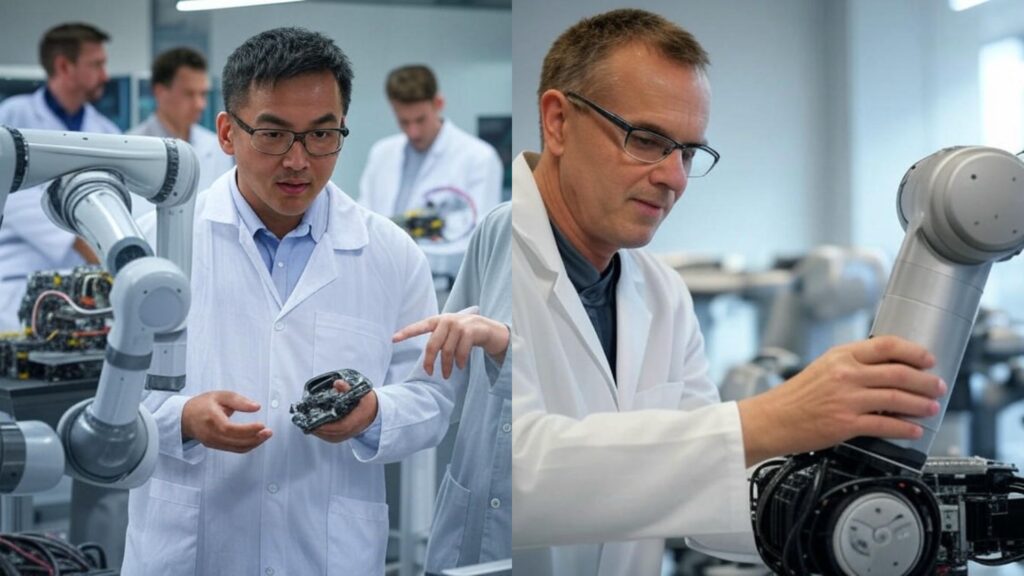The Future of Robotics Engineering Jobs: Opportunities, Challenges, and Innovations
Introduction
Robotics Engineering Jobs: The field of robotics engineering is rapidly evolving, blending mechanical engineering, artificial intelligence (AI), computer science, and electrical engineering to create intelligent machines. As industries increasingly adopt automation, the demand for skilled robotics engineers is skyrocketing. This article explores the latest trends, job opportunities, and challenges in robotics engineering careers while providing insights into how aspiring professionals can thrive in this dynamic field.

Why Robotics Engineering Jobs Are in High Demand
Robotics engineers design, build, and maintain robots for various industries, including:
- Manufacturing & Logistics – Industrial robots for assembly lines, warehouse automation (e.g., Amazon’s Kiva robots).
- Healthcare – Surgical robots (e.g., Da Vinci Surgical System), rehabilitation exoskeletons.
- Agriculture – Autonomous tractors, drones for crop monitoring.
- Defense & Space – Bomb-disposal robots, Mars rovers (e.g., NASA’s Perseverance).
- Consumer Electronics – AI-powered home assistants (e.g., Roomba, robotic pets).
With the global robotics market projected to exceed $200 billion by 2030, job prospects for robotics engineers are stronger than ever.
Top Robotics Engineering Jobs in 2024
- Robotics Software Engineer – Develops AI algorithms for robot perception and decision-making.
- Automation Engineer – Designs robotic systems for factories and smart warehouses.
- Mechatronics Engineer – Combines mechanical and electronic systems for advanced robotics.
- AI & Machine Learning Specialist for Robotics – Trains robots using deep learning and neural networks.
- Robotics Research Scientist – Works on cutting-edge innovations in universities and tech labs.
Salary Range: 80,000–150,000+ (varies by experience and specialization).
Key Skills Needed for Robotics Engineers
- Programming (Python, C++, ROS – Robot Operating System)
- Machine Learning & Computer Vision
- CAD & 3D Modeling (SolidWorks, AutoCAD)
- Control Systems & Sensor Integration
- Problem-Solving & Creativity
Challenges in Robotics Engineering
- High Development Costs – Building advanced robots requires significant investment.
- Ethical & Safety Concerns – Ensuring robots operate safely alongside humans.
- Rapid Technological Changes – Engineers must continuously upskill to stay relevant.
How to Start a Career in Robotics Engineering
- Earn a Degree – Bachelor’s/Master’s in Robotics, Mechanical, or Electrical Engineering.
- Gain Hands-On Experience – Internships, robotics competitions (e.g., FIRST Robotics).
- Build a Portfolio – Work on personal projects (e.g., DIY drones, robotic arms).
- Network with Professionals – Join IEEE Robotics or attend industry conferences.
The Future of Robotics Jobs
With advancements in AI, swarm robotics, and human-robot collaboration, the next decade will see robots becoming more autonomous and integrated into daily life. Engineers who embrace lifelong learning and interdisciplinary skills will lead this revolution.
Conclusion
Robotics engineering is one of the most exciting and lucrative career paths today. As automation reshapes industries, skilled engineers will drive innovation in AI-powered robotics. Whether you’re a student or a professional looking to transition into robotics, now is the perfect time to dive into this transformative field.
Click Here to buy and read a book on Reinventing Jobs: A 4-Step Approach for Applying Automation to Work
Other Related Articles:
Our Trending Article:
Solo Leveling Fitness Tracker by Solah
If you have any suggestions or queries, please feel free to text us in the comment box below:
